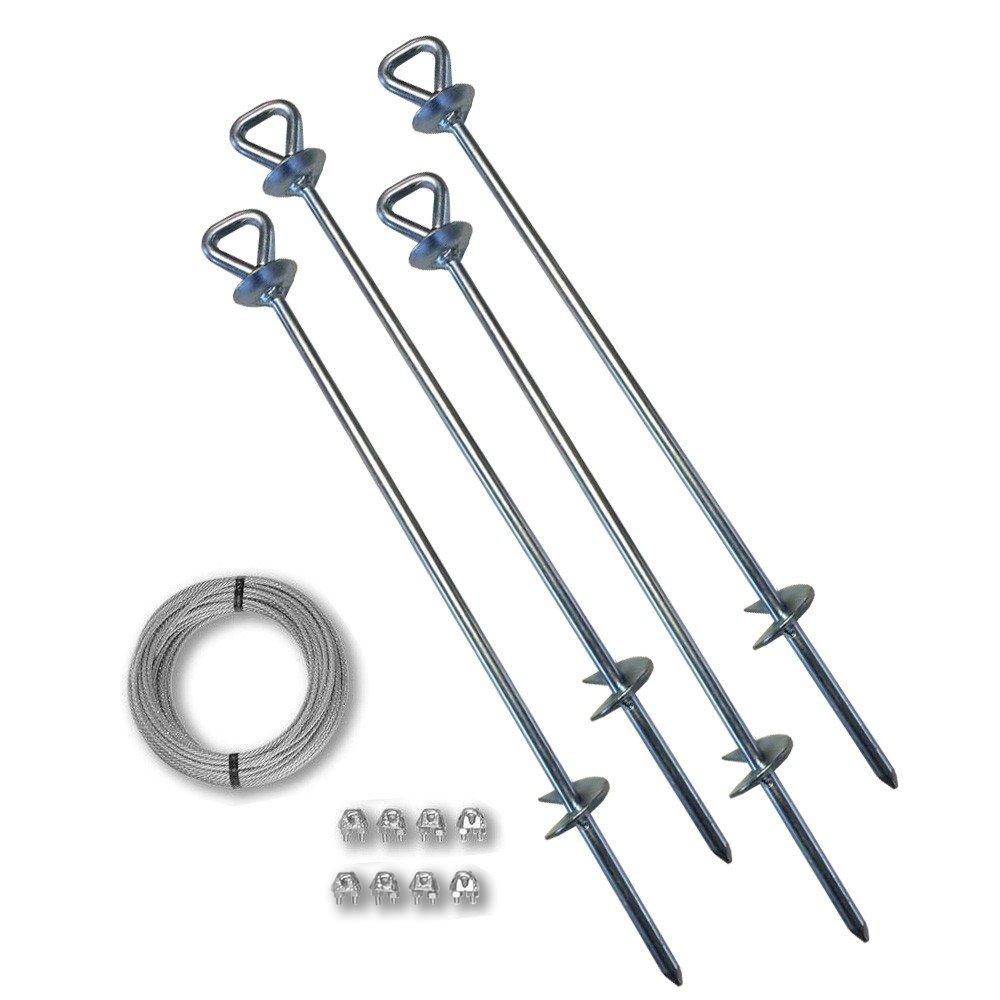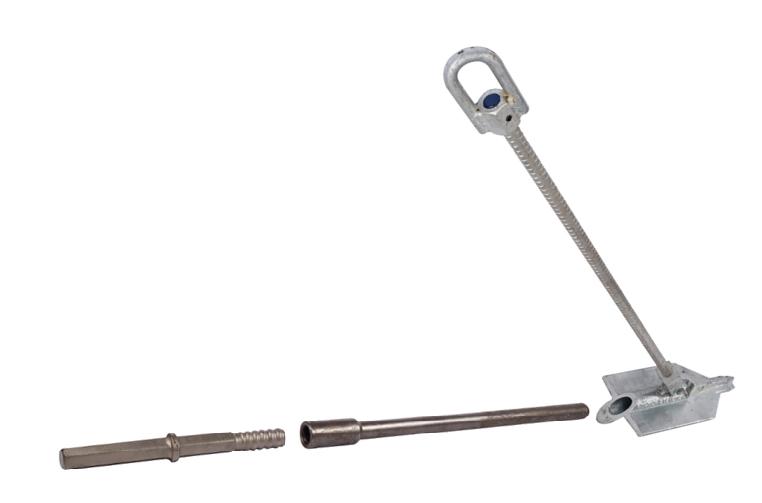Just How Durable Earth Anchors Work: A Comprehensive Overview to Dirt Anchoring Solutions
Durable Earth anchors play an important function in offering security and assistance in different building and construction applications. By installing deeply right into the ground, they stand up to side and vertical pressures successfully. Different kinds of anchors satisfy different dirt problems, making them versatile. Recognizing their mechanics and installation strategies is crucial for making the most of efficiency. What variables affect their performance, and exactly how do they compare to typical techniques? The answers may surprise you.
Recognizing Durable Earth Anchors
Durable Earth supports serve as essential elements in numerous construction and landscaping projects, giving stability and assistance in difficult dirt conditions. These supports work by being installed right into the ground, where they withstand lateral and vertical forces. Their style enables protected add-on to structures, ensuring they continue to be secured versus dirt activity or external loads.The effectiveness of heavy-duty Earth supports mainly relies on the sort of soil and the support's setup deepness. Appropriate installation strategies are important, as they figure out the support's holding capability. Environmental aspects, such as moisture and freeze-thaw cycles, can additionally influence performance.These supports are often utilized in applications ranging from safeguarding fencings and maintaining walls to maintaining short-lived frameworks throughout damaging climate conditions. Comprehending the concepts behind durable Earth anchors is vital for experts seeking to boost the durability and security of their tasks.
Types of Heavy-Duty Earth Anchors
Different kinds of heavy-duty Earth supports are designed to satisfy certain needs based on dirt conditions and task demands. Helical supports, featuring screw-like blades, are reliable in softer soils, providing high load abilities and very easy setup. Driven supports, which are inculcated the ground, appropriate for rocky surfaces and supply prompt load support. Tie-back anchors are commonly utilized in maintaining wall surface applications, enabling lateral support by anchoring into the ground at an angle. One more type is the cast-in-place support, ideal for concrete applications, as they are integrated right into foundations for boosted security. Ultimately, dirt screw supports are functional choices that can be utilized in numerous dirt types, supplying dependable stress and compression abilities. Each kind serves distinctive applications, ensuring security and safety in building and construction and landscape design jobs. Recognizing these choices enables for notified decisions in picking the proper Earth securing service.
The Mechanics of Dirt Anchoring

Recognizing the mechanics of soil anchoring calls for an evaluation of different types of Earth supports and their setup techniques. Each anchor type presents unique attributes that influence its effectiveness in different dirt problems. Appropriate setup techniques are vital for making best use of the securing system's security and efficiency.
Sorts Of Earth Anchors
Earth supports, important components in dirt anchoring systems, can be found in numerous types, each developed for specific applications and dirt conditions. One of the most usual types include screw supports, which are twisted into the ground, providing strong lateral resistance. Helical supports feature blades that enable reliable installment in numerous soil kinds, making them ideal for both irreversible and short-lived applications. Driven anchors, typically made from steel, are hammered right into the soil and are effective in thick or rough atmospheres. Auger supports make use of a helical style to promote installment in softer dirts. Finally, plate anchors contain a level plate hidden flat, dispersing lots over a larger area, suitable for applications requiring high load abilities in natural dirts.
Installation Techniques Clarified
Correct installation methods are crucial for the effectiveness of soil anchoring systems. The procedure usually starts with site assessment, confirming the picked area can sustain the support's lots. After establishing the right support kind, correct hole deepness and angle should be developed. The setup entails driving the anchor into the ground utilizing specialized devices, such as manual or hydraulic motorists, to accomplish finest embedment. Post-installation, tensioning the support is vital to guarantee stability; this is commonly validated with lots testing. Furthermore, bordering dirt problems ought to be kept track of to prevent displacement. Complying with these strategies not just boosts the support's performance but likewise lengthens its life-span, supplying reliable assistance for numerous applications.
Applications of Heavy-Duty Earth Anchors
While heavy-duty Earth supports are usually related to building and construction and landscape design, their adaptability prolongs to a selection of applications across various sectors. In civil engineering, they offer vital assistance for retaining walls, making sure stability in areas susceptible to soil erosion. The aquatic sector makes use of these anchors for securing docks and marinas, preventing movement triggered view publisher site by currents and tides. Furthermore, in the telecom sector, durable Earth anchors are significant for maintaining cell towers and other tall structures against wind pressures. Agricultural applications likewise profit, as these supports can secure structures like greenhouses and livestock fence, guaranteeing they endure harsh weather. In renewable power tasks, such as wind farms, Earth supports play a vital duty in safeguarding wind turbine foundations, improving overall safety and efficiency. This wide series of applications highlights the versatility and dependability of durable Earth anchors across numerous areas.
Advantages Over Traditional Anchoring Techniques
Traditional anchoring methods have actually long been counted upon for stability, sturdy Earth supports supply considerable advantages that boost efficiency and effectiveness. One significant benefit is their superior load-bearing ability, which permits them to stand up to better forces without failure. This strength makes them ideal for requiring applications, such as in construction and utility installations.Additionally, sturdy Earth anchors are developed for deeper setup, providing higher stability in different dirt conditions, consisting of sandy or loosened soils. Their resistance to rust and ecological aspects guarantees a longer life-span and reduced upkeep prices contrasted to standard methods.Moreover, these supports can be installed with very little disturbance to the surrounding location, protecting the honesty of the landscape. Generally, durable Earth anchors offer a reliable and effective service for securing demands, going beyond the constraints frequently linked with traditional anchoring techniques.
Installment Process and Best Practices
The installment procedure for dirt securing services starts with thorough preparation and site evaluation to guarantee peak performance. Following this, a step-by-step installment overview provides clear instructions for efficient execution (Manta Ray anchors). Sticking to these best methods is necessary for accomplishing lasting and reputable anchoring results
Prep Work and Website Evaluation
Efficient preparation and comprehensive website examination are important action in the installment of soil securing remedies. Before setup, the dirt type need to be examined to identify its bearing ability and suitability for securing. Conducting a geotechnical survey can supply important details concerning dirt composition, moisture degrees, and prospective ground movement. Additionally, determining existing frameworks, plant life, and utilities is vital to stay clear of interference throughout setup. The location ought to be free from debris and challenges to guarantee safe access for tools. Weather should likewise be monitored, as negative problems can influence both safety and security and installment efficacy. By meticulously preparing the site and reviewing all appropriate aspects, the likelihood of effective support performance is considerably raised.
Step-by-Step Setup Overview
A detailed installment process is essential for achieving suitable efficiency of dirt securing remedies. The installment begins with picking the ideal anchor kind and assuring the website is clear of particles. Next, correct hole positioning is figured out based upon tons requirements. Once the location is established, holes are drilled to the defined deepness and diameter utilizing the correct devices. The anchor is then inserted right into the hole, making certain it is lined up properly. After safeguarding the anchor, soil is backfilled and compacted to enhance stability. It is necessary to comply with maker guidelines throughout the process. A post-installation examination verifies that the anchors are adequately positioned and functioning as planned, supplying reliable assistance for the desired application.

Maintenance and Examination of Earth Anchors
Routine upkeep and assessment of Earth supports are vital for making sure long-lasting performance and stability. Routine checks permit the early discovery of issues such as corrosion, loosening, or soil motion. Assessors ought to look for indicators of rust or degradation on the anchor components, especially at the link factors. Additionally, the surrounding dirt ought to be examined for disintegration or modifications in moisture material, which can impact support effectiveness.It is advisable to establish a regular examination schedule, ideally at the very least once a year, relying on environmental problems. Throughout inspections, all visible parts need to be cleansed to get rid of dirt or particles that could hide prospective problems. Any kind of indicators of distress, such as tilting structures or uncommon settling, need to trigger instant evaluation. Correct documents of examinations can help in tracking anchor efficiency with time and promote timely upkeep actions, guaranteeing the supports continue to be reputable and functional.
Regularly Asked Questions
What Products Are Heavy-Duty Earth Anchors Generally Made From?
Durable Earth supports are usually created from resilient materials such as Visit Your URL galvanized steel or stainless-steel, making certain toughness and resistance to corrosion. These materials supply long-lasting support and security in various dirt problems and applications.
Just How Do Soil Problems Influence Anchor Efficiency?
Dirt problems substantially influence anchor performance. Aspects such as dirt type, dampness web content, and compaction affect the support's hold and security, with cohesive soils typically supplying site web far better resistance than loose or sandy dirts, influencing general effectiveness.
Can Heavy-Duty Earth Anchors Be Reused After Removal?
Sturdy Earth anchors can be reused after removal, supplied they are inspected for damage and wear. Correct cleansing and upkeep enhance their long life, making sure reliable performance in subsequent installations when conditions permit secure reinstallation.
What Are the Ecological Influences of Using Earth Anchors?
The environmental impacts of using Earth supports include possible dirt disruption, disturbance of local communities, and feasible contamination of groundwater. However, if made use of responsibly, their advantages frequently exceed these issues, promoting stability in numerous applications.
How Do I Choose the Right Anchor for My Project?

Comments on “Engineering Innovations in soil anchoring solutions for Renewable Energy Installations”